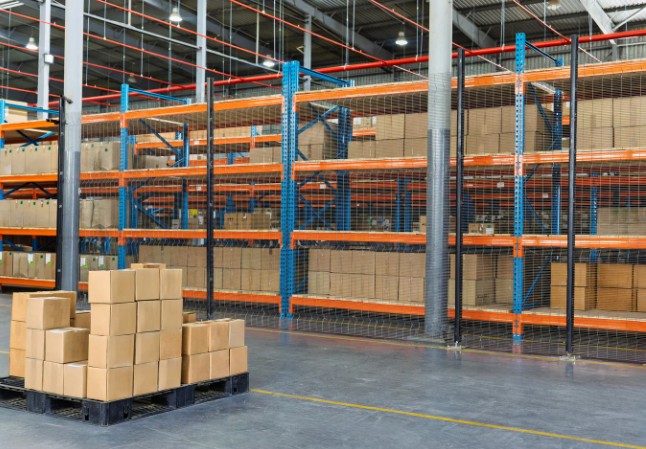The world of logistics and supply chain management is a perpetually evolving arena that demands constant refinement and optimisation. At the core of a streamlined logistics operation is the warehouse – a central hub that requires meticulous organisation to ensure efficiency and productivity.
An integral component of warehouse optimisation is the utilisation of pallet racking, a storage solution designed to maximise the use of space and improve the accessibility of goods. This article explores the significant role that pallet racking plays in enhancing warehouse operations and how businesses can leverage it for greater efficiency.
Understanding Pallet Racking Systems
Pallet racking systems are specifically engineered to accommodate materials on pallets within a warehouse setup. By organising these pallets in horizontal rows with multiple levels, they not only ensure that space is used effectively but also facilitate easy access to stored items. This translates into a warehouse that can manage a higher volume of goods without sacrificing the ability to quickly locate and move stock as required.
The Influence of Pallet Racking on Space Optimisation

The primary advantage of employing a pallet racking system is the optimisation of available space. When space is at a premium, as is often the case in warehouse environments, maximising vertical space is crucial.
Pallet racking enables warehouses to stack inventory higher, reducing the amount of ground square footage required for storage. This efficient use of vertical space is also instrumental in accommodating a broader range of products, a benefit that equates to enhanced stock variety and quicker response times to market demands.
Improving Accessibility and Workflow
Another critical aspect of pallet racking is its role in improving the workflow within a warehouse. Because items are stored on dedicated racking, it’s easier for warehouse personnel to locate and retrieve goods, helping speed up order fulfilment and reducing the potential for errors.
This systematic approach to storage can drastically reduce the time spent on picking and packing processes, directly affecting overall operational efficiency.
The Importance of Proper Racking Configuration
Effective warehouse optimisation through pallet racking requires careful consideration of the warehouse’s specific needs, including the type of goods stored, the turnover rate, and the handling equipment used.
Different racking configurations, such as selective, push-back, or drive-in racking, each offer unique advantages and must be chosen based on the operational requirements of the warehouse. Proper selection and setup of racking systems are thus essential to ensure maximum efficiency gains.
Enhancing Safety with Pallet Racking
It is paramount to note that a well-planned pallet racking system also contributes to a safer work environment. With goods neatly stored and easily retrievable, there are fewer risks associated with manual handling.
Additionally, the reduced need for machinery to travel extensive distances within the warehouse lowers the chance of accidents. Proper racking can protect both employees and goods, fostering a more secure and productive workspace.
Adapting to Change

Warehouses are dynamic environments that must adapt to the shifting sands of business demands. Flexibility in a pallet racking system can facilitate such changes, allowing for reconfiguration or expansion without significant disruptions.
As product ranges grow or shrink, an adaptable racking solution can adjust accordingly, ensuring the warehouse remains optimally organised over time.
Technological Integration
In today’s technological landscape, incorporating cutting-edge innovations into pallet racking systems is becoming increasingly common.
From radio-frequency identification (RFID) tags to warehouse management systems (WMS), technology can further streamline the process of tracking and handling products stored within the racking. This fosters even greater efficiencies and accuracy in inventory management.
Cost-Effectiveness of Pallet Racking
Although initial investment in a high-quality pallet racking system may seem substantial, the long-term savings associated with improved space utilisation and efficiency can be considerable.
By reducing the need for additional warehousing space and minimising wasted time in operations, businesses can realise significant financial gains over time.
Sustainability Considerations
The conversation surrounding sustainability is also relevant in warehouse optimisation. Efficient racking systems can lead to a reduction in energy costs, thanks to a reduced need for powered machinery.
Moreover, by maximising space efficiency, companies can limit their expansion footprint, positively impacting their carbon emissions and promoting a more sustainable approach to warehousing.
Customisation and Professional Guidance
Every warehouse has unique characteristics, which is why customisation of pallet racking systems is crucial. Partnering with experts in storage solutions gives businesses the opportunity to tailor their racking systems to their specific requirements.
Professional input during the design and installation process can ensure that the full benefits of pallet racking are realised, helping warehouses to operate at their peak potential.
Continual Maintenance and Inspection
Like any significant investment, maintaining the integrity of a pallet racking system is vital. Regular inspections and maintenance are necessary to prevent potential structural issues, which could lead to accidents or inefficiencies.
Enforcing strict maintenance routines ensures that the racking system remains in optimal condition, providing a consistent level of performance and safety.
The Future of Warehouse Optimisation
As commerce continues to accelerate, the future of warehouse optimisation will undoubtedly feature advancements in racking systems.
Innovations in design and materials may soon provide even more robust and flexible solutions. Furthermore, the integration of automation and robotics will continue to shape how pallet racking systems improve warehouse efficiency.
Conclusion
In the drive towards peak operational efficiency, a well-implemented pallet racking solution stands as a foundation for success in warehouse management. Its impact on space optimisation, workflow, safety and cost-effectiveness cannot be overstated. As businesses continue to seek competitive advantages, the importance of embracing and enhancing pallet racking systems will remain paramount. From the shop floor to the bottom line, the role of pallet racking in warehouse optimisation is both critical and transformative.
Additional Resources
For more information on designing and implementing a pallet racking system tailored to your specific warehouse needs, visit BR Storage Systems, which offers expert advice and solutions in innovative storage and racking methods.









